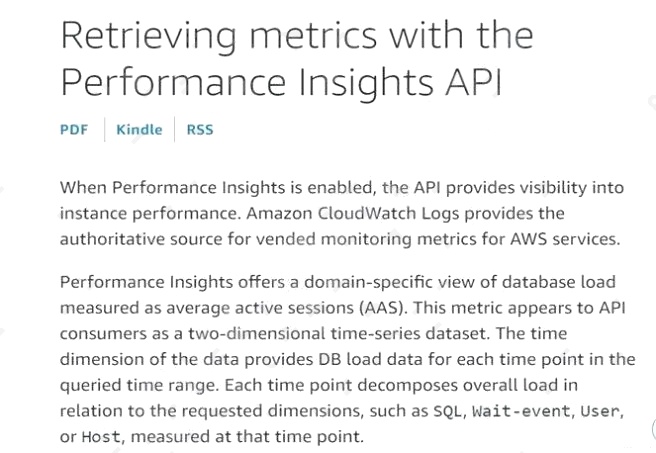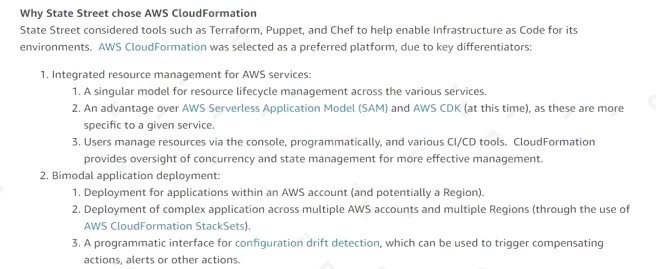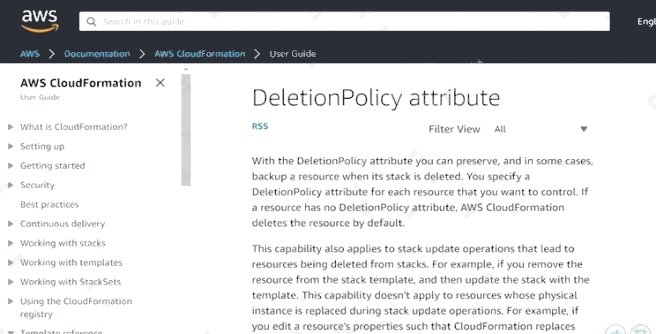amazon AWS Certified Database - Specialty exam practice questions
Questions for the AWS CERTIFIED DATABASE SPECIALTY DBS C01 were updated on : Jul 08 ,2025
Page 1 out of 16. Viewing questions 1-15 out of 234
Question 1
An Amazon RDS EBS-optimized instance with Provisioned IOPS (PIOPS) storage is using less than half of its allocated
IOPS over the course of several hours under constant load. The RDS instance exhibits multi-second read and write latency,
and uses all of its maximum bandwidth for read throughput, yet the instance uses less than half of its CPU and RAM
resources. What should a Database Specialist do in this situation to increase performance and return latency to sub-second
levels?
- A. Increase the size of the DB instance storage
- B. Change the underlying EBS storage type to General Purpose SSD (gp2)
- C. Disable EBS optimization on the DB instance
- D. Change the DB instance to an instance class with a higher maximum bandwidth
Answer:
B
Question 2
An ecommerce company is migrating its core application database to Amazon Aurora MySQL. The company is currently
performing online transaction processing (OLTP) stress testing with concurrent database sessions. During the first round of
tests, a database specialist noticed slow performance for some specific write operations.
Reviewing Amazon CloudWatch metrics for the Aurora DB cluster showed 90% CPU utilization.
Which steps should the database specialist take to MOST effectively identify the root cause of high CPU utilization and slow
performance? (Choose two.)
- A. Enable Enhanced Monitoring at less than 30 seconds of granularity to review the operating system metrics before the next round of tests.
- B. Review the VolumeBytesUsed metric in CloudWatch to see if there is a spike in write I/O.
- C. Review Amazon RDS Performance Insights to identify the top SQL statements and wait events.
- D. Review Amazon RDS API calls in AWS CloudTrail to identify long-running queries.
- E. Enable Advance Auditing to log QUERY events in Amazon CloudWatch before the next round of tests.
Answer:
B C
Explanation:
Reference: https://docs.aws.amazon.com/AmazonRDS/latest/UserGuide/USER_PerfInsights.API.html
Question 3
A media company wants to use zero-downtime patching (ZDP) for its Amazon Aurora MySQL database. Multiple processing
applications are using SSL certificates to connect to database endpoints and the read replicas.
Which factor will have the LEAST impact on the success of ZDP?
- A. Binary logging is enabled, or binary log replication is in progress.
- B. Current SSL connections are open to the database.
- C. Temporary tables or table locks are in use.
- D. The value of the lower_case_table_names server parameter was set to 0 when the tables were created.
Answer:
A
Explanation:
Aurora MySQL 2.10 and higher, Aurora can perform a zero-downtime patch when binary log replication is enabled.
Reference: https://docs.aws.amazon.com/AmazonRDS/latest/AuroraUserGuide/AuroraMySQL.Updates.Patching.html
Question 4
A company is building a software as a service application. As part of the new user sign-on workflow, a Python script invokes
the CreateTable operation using the Amazon DynamoDB API. After the call returns, the script attempts to call PutItem.
Occasionally, the PutItem request fails with a ResourceNotFoundException error, which causes the workflow to fail. The
development team has confirmed that the same table name is used in the two API calls.
How should a database specialist fix this issue?
- A. Add an allow statement for the dynamodb:PutItem action in a policy attached to the role used by the application creating the table.
- B. Set the StreamEnabled property of the StreamSpecification parameter to true, then call PutItem.
- C. Change the application to call DescribeTable periodically until the TableStatus is ACTIVE, then call PutItem.
- D. Add a ConditionExpression parameter in the PutItem request.
Answer:
D
Explanation:
Reference: https://docs.aws.amazon.com/amazondynamodb/latest/APIReference/API_PutItem.html
Question 5
A company is running a two-tier ecommerce application in one AWS account. The web server is deployed using an Amazon
RDS for MySQL Multi-AZ DB instance. A Developer mistakenly deleted the database in the production environment. The
database has been restored, but this resulted in hours of downtime and lost revenue.
Which combination of changes in existing IAM policies should a Database Specialist make to prevent an error like this from
happening in the future? (Choose three.)
- A. Grant least privilege to groups, users, and roles
- B. Allow all users to restore a database from a backup that will reduce the overall downtime to restore the database
- C. Enable multi-factor authentication for sensitive operations to access sensitive resources and API operations
- D. Use policy conditions to restrict access to selective IP addresses
- E. Use AccessList Controls policy type to restrict users for database instance deletion
- F. Enable AWS CloudTrail logging and Enhanced Monitoring
Answer:
A C D
Question 6
A companys ecommerce website uses Amazon DynamoDB for purchase orders. Each order is made up of a Customer ID
and an Order ID. The DynamoDB table uses the Customer ID as the partition key and the Order ID as the sort key.
To meet a new requirement, the company also wants the ability to query the table by using a third attribute named Invoice
ID. Queries using the Invoice ID must be strongly consistent. A database specialist must provide this capability with optimal
performance and minimal overhead.
What should the database administrator do to meet these requirements?
- A. Add a global secondary index on Invoice ID to the existing table.
- B. Add a local secondary index on Invoice ID to the existing table.
- C. Recreate the table by using the latest snapshot while adding a local secondary index on Invoice ID.
- D. Use the partition key and a FilterExpression parameter with a filter on Invoice ID for all queries.
Answer:
C
Question 7
A Database Specialist is troubleshooting an application connection failure on an Amazon Aurora DB cluster with multiple
Aurora Replicas that had been running with no issues for the past 2 months. The connection failure lasted for 5 minutes and
corrected itself after that. The Database Specialist reviewed the Amazon RDS events and determined a failover event
occurred at that time. The failover process took around 15 seconds to complete.
What is the MOST likely cause of the 5-minute connection outage?
- A. After a database crash, Aurora needed to replay the redo log from the last database checkpoint
- B. The client-side application is caching the DNS data and its TTL is set too high
- C. After failover, the Aurora DB cluster needs time to warm up before accepting client connections
- D. There were no active Aurora Replicas in the Aurora DB cluster
Answer:
C
Question 8
A company has an Amazon RDS Multi-AZ DB instances that is 200 GB in size with an RPO of 6 hours. To meet the
companys disaster recovery policies, the database backup needs to be copied into another Region. The company requires
the solution to be cost-effective and operationally efficient.
What should a Database Specialist do to copy the database backup into a different Region?
- A. Use Amazon RDS automated snapshots and use AWS Lambda to copy the snapshot into another Region
- B. Use Amazon RDS automated snapshots every 6 hours and use Amazon S3 cross-Region replication to copy the snapshot into another Region
- C. Create an AWS Lambda function to take an Amazon RDS snapshot every 6 hours and use a second Lambda function to copy the snapshot into another Region
- D. Create a cross-Region read replica for Amazon RDS in another Region and take an automated snapshot of the read replica
Answer:
D
Explanation:
Reference: https://aws.amazon.com/blogs/database/implementing-a-disaster-recovery-strategy-with-amazon-rds/
Question 9
A company is using a Single-AZ Amazon RDS for MySQL DB instance for development. The DB instance is experiencing
slow performance when queries run. Amazon CloudWatch metrics indicate that the instance requires more I/O capacity.
Which actions can a database specialist perform to resolve this issue? (Choose two.)
- A. Restart the application tool used to run queries.
- B. Change to a database instance class with higher throughput.
- C. Convert from Single-AZ to Multi-AZ.
- D. Increase the I/O parameter in Amazon RDS Enhanced Monitoring.
- E. Convert from General Purpose to Provisioned IOPS (PIOPS).
Answer:
B D
Question 10
A manufacturing companys website uses an Amazon Aurora PostgreSQL DB cluster.
Which configurations will result in the LEAST application downtime during a failover? (Choose three.)
- A. Use the provided read and write Aurora endpoints to establish a connection to the Aurora DB cluster.
- B. Create an Amazon CloudWatch alert triggering a restore in another Availability Zone when the primary Aurora DB cluster is unreachable.
- C. Edit and enable Aurora DB cluster cache management in parameter groups.
- D. Set TCP keepalive parameters to a high value.
- E. Set JDBC connection string timeout variables to a low value.
- F. Set Java DNS caching timeouts to a high value.
Answer:
A B C
Question 11
An ecommerce company is using Amazon DynamoDB as the backend for its order-processing application. The steady
increase in the number of orders is resulting in increased DynamoDB costs. Order verification and reporting perform many
repeated GetItem functions that pull similar datasets, and this read activity is contributing to the increased costs. The
company wants to control these costs without significant development efforts.
How should a Database Specialist address these requirements?
- A. Use AWS DMS to migrate data from DynamoDB to Amazon DocumentDB
- B. Use Amazon DynamoDB Streams and Amazon Kinesis Data Firehose to push the data into Amazon Redshift
- C. Use an Amazon ElastiCache for Redis in front of DynamoDB to boost read performance
- D. Use DynamoDB Accelerator to offload the reads
Answer:
B
Question 12
A company is building a web application on AWS. The application requires the database to support read and write
operations in multiple AWS Regions simultaneously. The database also needs to propagate data changes between Regions
as the changes occur. The application must be highly available and must provide latency of single-digit milliseconds.
Which solution meets these requirements?
- A. Amazon DynamoDB global tables
- B. Amazon DynamoDB streams with AWS Lambda to replicate the data
- C. An Amazon ElastiCache for Redis cluster with cluster mode enabled and multiple shards
- D. An Amazon Aurora global database
Answer:
A
Explanation:
Global tables enable you to read and write your data locally providing single-digit-millisecond latency for your globally
distributed application at any scale. Reference: https://aws.amazon.com/dynamodb/global-tables/
Question 13
A Database Specialist is creating Amazon DynamoDB tables, Amazon CloudWatch alarms, and associated infrastructure for
an Application team using a development AWS account. The team wants a
deployment method that will standardize the core solution components while managing environment-specific settings
separately, and wants to minimize rework due to configuration errors. Which process should the Database Specialist
recommend to meet these requirements?
- A. Organize common and environmental-specific parameters hierarchically in the AWS Systems Manager Parameter Store, then reference the parameters dynamically from an AWS CloudFormation template. Deploy the CloudFormation stack using the environment name as a parameter.
- B. Create a parameterized AWS CloudFormation template that builds the required objects. Keep separate environment parameter files in separate Amazon S3 buckets. Provide an AWS CLI command that deploys the CloudFormation stack directly referencing the appropriate parameter bucket.
- C. Create a parameterized AWS CloudFormation template that builds the required objects. Import the template into the CloudFormation interface in the AWS Management Console. Make the required changes to the parameters and deploy the CloudFormation stack.
- D. Create an AWS Lambda function that builds the required objects using an AWS SDK. Set the required parameter values in a test event in the Lambda console for each environment that the Application team can modify, as needed. Deploy the infrastructure by triggering the test event in the console.
Answer:
C
Explanation:
Reference: https://aws.amazon.com/blogs/mt/aws-cloudformation-signed-sealed-and-deployed/
Question 14
A company is loading sensitive data into an Amazon Aurora MySQL database. To meet compliance requirements, the
company needs to enable audit logging on the Aurora MySQL DB cluster to audit database activity. This logging will include
events such as connections, disconnections, queries, and tables queried. The company also needs to publish the DB logs to
Amazon CloudWatch to perform realtime data analysis.
Which solution meets these requirements?
- A. Modify the default option group parameters to enable Advanced Auditing. Restart the database for the changes to take effect.
- B. Create a custom DB cluster parameter group. Modify the parameters for Advanced Auditing. Modify the cluster to associate the new custom DB parameter group with the Aurora MySQL DB cluster.
- C. Take a snapshot of the database. Create a new DB instance, and enable custom auditing and logging to CloudWatch. Deactivate the DB instance that has no logging.
- D. Enable AWS CloudTrail for the DB instance. Create a filter that provides only connections, disconnections, queries, and tables queried.
Answer:
A
Explanation:
Reference: https://aws.amazon.com/blogs/database/configuring-an-audit-log-to-capture-database-activities-for-amazon-rds-
for-mysql-and-amazon-aurora-with-mysql-compatibility/
Question 15
An AWS CloudFormation stack that included an Amazon RDS DB instance was accidentally deleted and recent data was
lost. A Database Specialist needs to add RDS settings to the CloudFormation template to reduce the chance of accidental
instance data loss in the future.
Which settings will meet this requirement? (Choose three.)
- A. Set DeletionProtection to True
- B. Set MultiAZ to True
- C. Set TerminationProtection to True
- D. Set DeleteAutomatedBackups to False
- E. Set DeletionPolicy to Delete
- F. Set DeletionPolicy to Retain
Answer:
A C F
Explanation:
Reference: https://docs.aws.amazon.com/AWSCloudFormation/latest/UserGuide/aws-attribute-deletionpolicy.html
https://aws.amazon.com/premiumsupport/knowledge-center/cloudformation-accidental-updates/